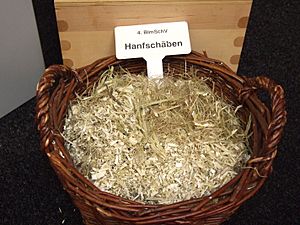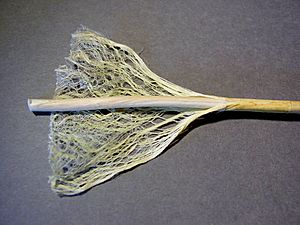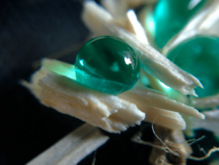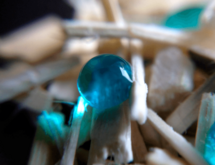Shives facts for kids
Shives (say 'shyves'), also known as shoves, boon, or hurd, are the woody parts left over when plants like flax, hemp, or jute are processed. Imagine breaking a plant stem – the tough outer strings are the fibers, and the softer, woody bits inside are the shives. Shives are a natural by-product, meaning they are created when we get the useful fibers from these plants.
How Shives Are Separated
Separating the valuable fibers from the shives is called decortication. These strong fibers, known as 'bast fibers,' are used to make things like textiles (fabric). This separation can be done by hand, which takes a lot of effort, or by special machines called decorticators.
What Shives Are Used For

Even though shives are a by-product, they are very useful! Here are some ways they can be used:
- Papermaking: Shives can be used to make paper.
- Building Materials: They can be turned into materials like particleboard or hempcrete. These are used in construction.
- Animal Bedding: One of the most common uses for shives, especially in Europe, is as soft bedding for animals, like in horse stalls.
Protecting Shives for Building
Hemp shives are a natural material that can be used to make insulation boards for buildings. These boards help keep homes warm in winter and cool in summer. However, because shives are made mostly of cellulose (like wood), they can catch fire. Also, they tend to soak up water easily, which can lead to mold or rot.
Scientists are working on ways to protect shives. They have found that coating shives with a special water-repellent (water-resisting) film can help. This coating uses tiny silica particles. Tests show that shives treated this way can stay dry even in humid conditions. They also resist mold growth for a long time.
This special treatment could make shive-based insulation much more useful in construction. Before it can be widely used, more tests are needed to make sure it meets all building safety rules.





